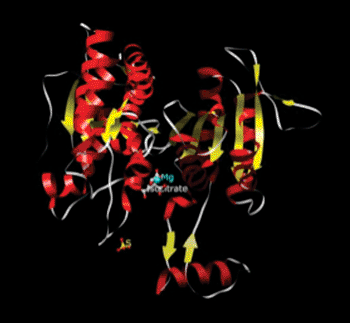Isocitrate Dehydrogenase Identified as Biomarker for Lung Cancer Diagnosis
By LabMedica International staff writers
Posted on 30 Sep 2013
The enzyme isocitrate dehydrogenase (IDH1) can be used as a plasma biomarker for the diagnosis of non-small-cell lung cancers (NSCLCs), particularly lung adenocarcinoma, with relatively high sensitivity and specificity.Posted on 30 Sep 2013
Lung cancer is the leading cause of cancer-related mortality in the US and worldwide about 85% of the cases are NSCLC. Presently there are few validated biomarkers that can predict NSCLC survival or treatment, and most are based on nonselective tumor markers.

Image: Crystallographic structure of isocitrate dehydrogenase (Photo courtesy of Wikimedia Commons).
IDH1 catalyzes the oxidation of isocitrate to 2-oxoglutarate and carbon dioxide, with reduction of NAD+ to NADH. In mammalian tissues, this enzyme is localized exclusively in the mitochondria. Investigators at the Chinese Academy of Medical Sciences (Beijing) had showed previously that IDH1 was significantly increased in NSCLC tumors. In the current study, they evaluated the usefulness of measuring plasma IDH1 levels for diagnosis of NSCLC.
Toward this end, the investigators used ELISA methodology to determine the plasma levels of IDH1 and of the tumor markers CA125, Cyfra21-1, and CEA in blood samples obtained from 943 patients with NSCLC and 479 healthy controls.
Results showed that IDH1 could be detected in the blood of lung cancer patients with 76% sensitivity and 77% specificity. A mathematical model that combined the measurement of IDH1 with determination of the tumor markers CEA, Cyfra21-1, and CA125, increased the sensitivity to 86%. The median IDH1 levels in patients with two types of lung cancer, adenocarcinoma and squamous cell carcinoma, were 2.7-fold and 2.2-fold higher, respectively, compared with healthy controls.
“This study is the first to report identification of IDH1 as a novel biomarker for the diagnosis of non-small-cell lung cancers (NSCLC) using a large number of clinical samples,” said senior author Dr. Jie He, director of the laboratory of thoracic surgery at the Chinese Academy of Medical Sciences. “Lung cancer has a high mortality rate, mostly because of late diagnosis. With an increase in aging population, we are likely to see an increase in lung cancer incidence and a need for better biomarkers for early diagnosis. We have identified IDH1 as an effective plasma biomarker with high sensitivity and specificity in the diagnosis of NSCLC, especially lung adenocarcinoma.”
The study was published in the September 15, 2013, issue of the journal Clinical Cancer Research.
Related Links:
Chinese Academy of Medical Sciences














